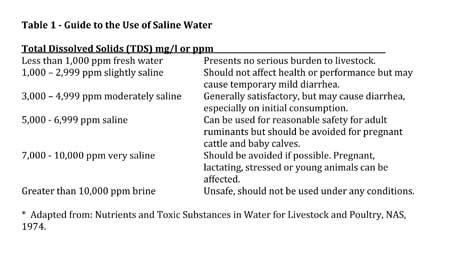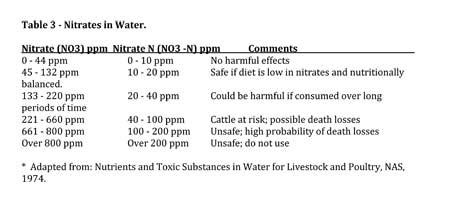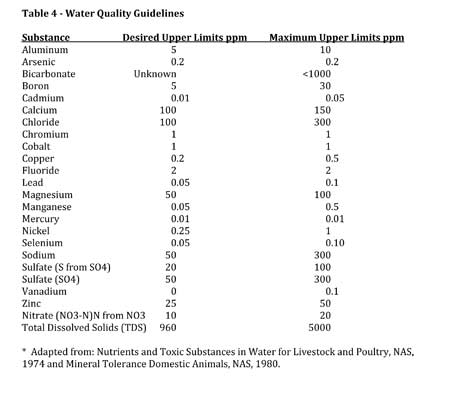by: Stephen B. Blezinger
Ph.D., PAS
Part 3 � Water Evaluation
Of all the nutrients, water is the most important and often the most taken for granted. It is the most abundant component in all living organisms with the body of the typical adult mammal composed of about 60 percent water. Its importance is emphasized in that of all the nutrients, water is needed on the most regular basis and in the highest volume.
Reviewing quickly, water is important for the transport of nutrients between cells and as a vital medium for intracellular metabolism. It is needed for body temperature regulation and the digestion, absorption, and utilization of all other nutrients. As such, water plays an essential role in every life process. Beef cattle need regular access to clean drinking water in order to experience optimum health. Research has demonstrated a positive relationship between access to clean drinking water and performance factors such as growth, reproduction, and milk production. Animals that drink clean, contaminant-free water are generally less prone to illness and disease, gain more weight, and produce more milk. Producers have a great deal of control over both the quantity and quality of water that is provided to animals. Monitoring water quality and observing good water management are inexpensive yet effective ways to improve overall animal performance.
Common Contaminants of Drinking Water
Livestock drinking water may be contaminated by a number of factors including minerals (total dissolved solids, or TDS), manure, microorganisms, and algae. These contaminants can impact the appearance, odor, and taste of drinking water as well as its physical and chemical properties. Some contaminants may directly impact animal health by causing disease and infection; others have a more indirect effect and may cause cattle to decrease their overall water intake. When water intake is reduced, feed intake will also decrease, and, as a result, animals will gain less weight. Livestock can survive for as long as sixty days with little or no food, but only seven days without water. In very warm areas, like much of the southern United States, that number may be even less.
When the mineral content of water exceeds safe levels, animal performance can suffer. High levels of sodium (salt) depress water intake and result in weight loss and diarrhea. Animals exposed to water that is high in sulfur have increased incidences of polioencephalomacia (PEM) and experience higher mortality rates. Salinity of water, the concentration of dissolved salts in water, can be expressed as either TDS or TSS (Total Soluble Salts). Electrolytes or ions that regulate or affect metabolic processes, such as magnesium (Mg+), calcium (Ca+), sodium (Na+), and chloride (Cl-), contribute to the salinity of water. At certain high levels, these electrolytes can, in fact cause toxic effects by themselves or by interfering with the absorption of other important nutrients. Alone, however, TDS, TSS, or even EC tell us little about the quality of any water sample. However, these are indicators that when elevated give us a clue that some minerals may merit further and more precise analysis.
Manure is a common contaminant in cattle drinking water, particularly when the primary source of water is a pond where cattle may spend a good deal of time loitering. Manure is carried into drinking water on the cattle's hooves and is deposited directly when the animals defecate. Livestock drinking water that is contaminated with manure can become a hotspot for bacterial growth, which in turn can cause animal disease. High levels of bacteria have been found in cattle watering ponds where they may contribute to outbreaks of coliform related illnesses caused by E. coli, E. aerogenes, and Klebsiella species. These can lead to mastitis, urinary tract infections, diarrhea and numerous other unsavory and often lethal infections.
Fecal contamination of livestock drinking water can cause algae blooms through a process known as nutrient loading. Blue-green algae are common contaminants in standing water. When ponds become overgrown with algae, cattle will avoid drinking from them in favor of other water sources, if any exist. If no other source of fresh drinking water is available, they will decrease their overall water intake, which results in poorer performance. In addition to blue-green algae, other water-borne microbes can negatively impact animal health. Leptospirosis, which causes reproductive loss in cows, is spread by a microorganism found in water contaminated by urine. The soil-borne microbe believed to be primarily responsible for foot rot (F. necrophorum) can also be spread by consumption of contaminated water.
Evaluation of Drinking Water Management Practices
Cattle producers have the opportunity to enhance animal health and performance by improving the quality of water offered to their animals. Small changes in water management may result in improved performance associated with decreased potential for illness and disease.
The first step in improving water quality is to do a thorough evaluation of the current situation. Following are some tips to help guide the development of your on-farm protocol for water quality:
1) Is water offered in adequate quantity for the number and type of animals on your property? At least two feet of accessible linear water space is needed per 10 head of cattle.
2) Are watering devices spaced appropriately and located away from stream banks? Watering devices should be easily accessible by animals. Strategic placement of watering devices can influence grazing, compaction, and nutrient deposition patterns.
3) Is water offered fresh or from a pond? Recent research has shown that heifers with access to water pumped from a well or spring gained 23 percent more weight than heifers drinking pond water.
4) How often are watering devices cleaned? Increasing the frequency of cleaning may improve milk production in brood cows.
Water Quality Guidelines
The minimum requirement of cattle for water is a reflection of that needed for body growth; for fetal growth or lactation; and of that lost by excretion in the urine, feces, or sweat or by evaporation from the lungs or skin. Water requirements are affected by many factors, and it is impossible to list specific requirements with accuracy. The major influences on water intake in beef cattle fed typical rations are dry matter intake, environmental temperature, and stage and type of production. Water quality is important in maintaining water consumption of cattle. Factors such as pH, total dissolved solids, hardness, odor and taste as well as compounds present in excess (nitrates, iron, sodium, sulfates, and fluorine), toxic compounds (arsenic, cyanide, lead, mercury, hydrocarbons, organochlorides and organophosphates) and bacteria are criteria for evaluating drink water for humans and livestock. Water components can also have a direct effect on mineral balance and status in the animal. As mentioned previously, in many cases minerals such as Sulfur are more soluble than in feeds or forages and thus can have a greater antagonistic affect on the absorption of other minerals such as Copper or Selenium.
Some parameters we use to indicate water quality include salinity, total dissolved solids, hardness, nitrates and mineral levels. The following provides some guidelines of these.
Salinity
Salinity refers to the amount of dissolved salts in water and is measured by total dissolved solids. These dissolved salts are primarily sodium chloride but may include carbonates, nitrates, sulfates, calcium, magnesium and potassium. (See table 1).
 |
Salinity is part of the total dissolved solids but is not hardness. For an example, high saline waters may contain high degree of salt and yet not be hard due to the lack of magnesium and calcium. Concentration of calcium and magnesium contributes to hardness. Hardness, calcium plus magnesium classification is defined in Table 2.
 |
Degree of hardness does not seem to effect livestock production. An exception to this may be, as indicated above if the level of these minerals interferes with the absorption of others. For instance, high levels of calcium in the diet are known to reduce the absorption of selenium.
Nitrates
Cattle performance and reproduction is effected by nitrates in the water. Nitrate (NO3 ) is reduced to nitrite (NO2) which creates the toxicity. Additionally, nitrate levels in water in excess of .3 mg of nitrate nitrogen per liter contributes to excessive algae growth. Table 3 is a guide to levels of nitrate and nitrate nitrogen and precautions.
 |
Water Quality Guidelines � Mineral Levels
Overall water quality is also heavily affected by the levels of a variety of minerals in the water source.
Table 4 provides some indications of these levels.
 |
Conclusions
Water is a critical and often overlooked nutrient. The quality of the water provided for livestock often means huge differences in performance in terms of gains, milk production and health. Evaluating and correcting issues within the water supply can often have a substantial impact on profitability.
Copyright 2016 � Dr. Stephen B. Blezinger. Dr. Steve Blezinger is a nutritional and management consultant with an office in Sulfur Springs, TX. He can be reached at (903) 352-3475 or by email at [email protected]. For more information please visit us at Facebook/Reveille Livestock Concepts.
Don't forget to
BOOKMARK
Cattle Today Online!
